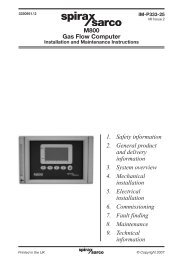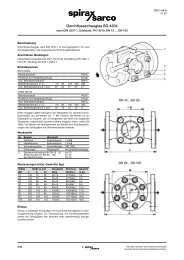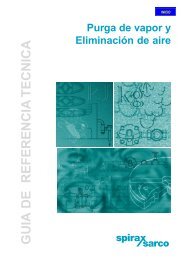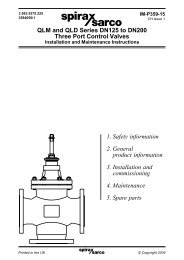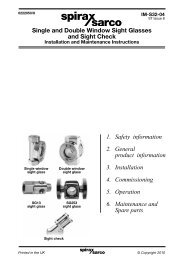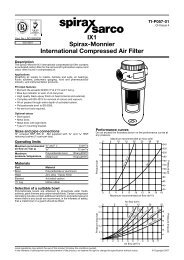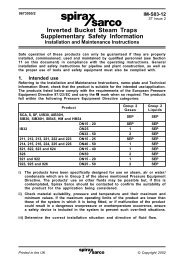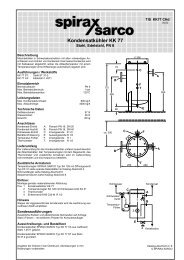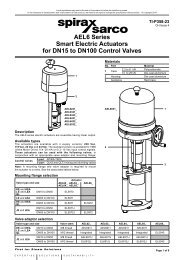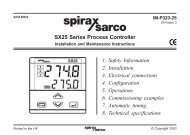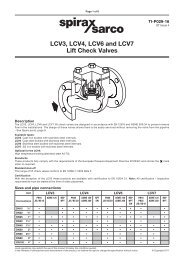2000 Hook-up Book - Spirax Sarco
2000 Hook-up Book - Spirax Sarco
2000 Hook-up Book - Spirax Sarco
Create successful ePaper yourself
Turn your PDF publications into a flip-book with our unique Google optimized e-Paper software.
SYSTEM DESIGN<br />
48<br />
Condensate Pumping<br />
In nearly all steam-using plants,<br />
condensate must be pumped<br />
from the location where it is<br />
formed back to the boilerhouse,<br />
or in those cases where gravity<br />
drainage to the boilerhouse is<br />
practical, the condensate must be<br />
lifted into a boiler feed tank or<br />
deaerator. Even where deaerators<br />
are at low level, they usually<br />
operate at a pressure a few psi<br />
above atmospheric and again, a<br />
pump is needed to lift condensate<br />
from atmospheric pressure to<br />
deaerator tank pressure.<br />
Electric Condensate<br />
Return Pumps<br />
When using electric pumps to lift<br />
the condensate, packaged units<br />
comprising a receiver tank (usually<br />
vented to atmosphere) and<br />
one or more motorized pumps<br />
are commonly used. It is important<br />
with these units to make sure<br />
that the maximum condensate<br />
temperature specified by the<br />
manufacturer is not exceeded,<br />
and the pump has sufficient<br />
capacity to handle the load.<br />
Condensate temperature usually<br />
presents no problem with returns<br />
from low pressure heating systems.<br />
There, the condensate is<br />
often below 212°F as it passes<br />
through the traps, and a little further<br />
subcooling in the gravity<br />
return lines and in the pump<br />
receiver itself means that there is<br />
little difficulty in meeting the maximum<br />
temperature limitation. See<br />
Fig. II-74 (page 119).<br />
On high pressure systems,<br />
the gravity return lines often contain<br />
condensate at just above<br />
212°F, together with some flash<br />
steam. The cooling effect of the<br />
piping is limited to condensing a<br />
little of the flash steam, with the<br />
remainder passing through the<br />
vent at the pump receiver. The<br />
water must remain in the receiver<br />
for an appreciable time if it is to<br />
cool sufficiently, or the pump discharge<br />
may have to be throttled<br />
down to reduce the pump’s capacity<br />
if cavitation is to be avoided.<br />
See Fig. II-75 (page 119).<br />
The PUMP NPSH in any given application can readily be estimated<br />
from:<br />
NPSH = hsv = 144 (Pa - Pvp) + hs - hf<br />
W<br />
Where:<br />
Pa = Absolute pressure in<br />
receiver s<strong>up</strong>plying pump,<br />
in psi (that is at atmospheric<br />
pressure in the<br />
case of a vented receiver).<br />
Pvp= Absolute pressure of<br />
condensate at the liquid<br />
temperature, in psi.<br />
The absolute pressure at the<br />
inlet to the pump is usually the<br />
atmospheric pressure in the<br />
receiver, plus the static head from<br />
the water surface to the pump<br />
inlet, minus the friction loss<br />
through pipes, valves and fittings<br />
between the receiver and the<br />
pump. If this absolute pressure<br />
exceeds the vapor pressure of<br />
water at the temperature at which<br />
it enters the pump, then a Net<br />
Positive Suction Head exists.<br />
Providing this NPSH is above the<br />
value specified by the pump manufacturer,<br />
the water does not<br />
begin to boil as it enters the pump<br />
suction, and cavitation is avoided.<br />
If the water entering the pump is<br />
at high temperature, its vapor<br />
pressure is increased and a<br />
greater hydrostatic head over the<br />
pump suction is needed to ensure<br />
that the necessary NPSH is<br />
obtained.<br />
If the water does begin to boil<br />
in the pump suction, the bubbles<br />
of steam are carried with the<br />
water to a high pressure zone in<br />
the pump. The bubbles then<br />
implode with hammer-like blows,<br />
eroding the pump and eventually<br />
destroying it. The phenomenon is<br />
called cavitation and is readily<br />
recognized by its typical rattle-like<br />
noise, which usually diminishes<br />
as a valve at the pump outlet is<br />
closed down.<br />
However, since in most cases<br />
pumps are s<strong>up</strong>plied co<strong>up</strong>led to<br />
receivers and the static head<br />
hs = Total suction head in feet.<br />
(Positive for a head above<br />
the pump or negative for a<br />
lift to the pump)<br />
hf = Friction loss in suction piping.<br />
W = Density of water in pounds<br />
per cubic foot at the<br />
appropriate temperature.<br />
above the pump inlet is already<br />
fixed by the pump manufacturer, it<br />
is only necessary to ensure that<br />
the pump set has sufficient<br />
capacity at the water temperature<br />
expected at the pump. Pump<br />
manufacturers usually have a set<br />
of capacity curves for the pump<br />
when handling water at different<br />
temperatures and these should<br />
be consulted.<br />
Where steam systems operate<br />
at higher pressures than<br />
those used in LP space heating<br />
systems, as in process work, condensate<br />
temperatures are often<br />
212°F, or more where positive<br />
pressures exist in return lines.<br />
Electric pumps are then used<br />
only if their capacity is downrated<br />
by partial closure of a valve at the<br />
outlet; by using a receiver mounted<br />
well above the pump to ensure<br />
sufficient NPSH; or by subcooling<br />
the condensate through a heat<br />
exchanger of some type.<br />
Pressure Powered Condensate<br />
Pump<br />
All these difficulties are avoided<br />
by the use of non-electric condensate<br />
pumps, such as the<br />
Pressure Powered Pump . The<br />
Pressure Powered Pump is<br />
essentially an alternating receiver<br />
which can be pressurized, using<br />
steam, air or other gas. The gas<br />
pressure displaces the condensate<br />
(which can be at any<br />
temperature <strong>up</strong> to and including<br />
boiling point) through a check



